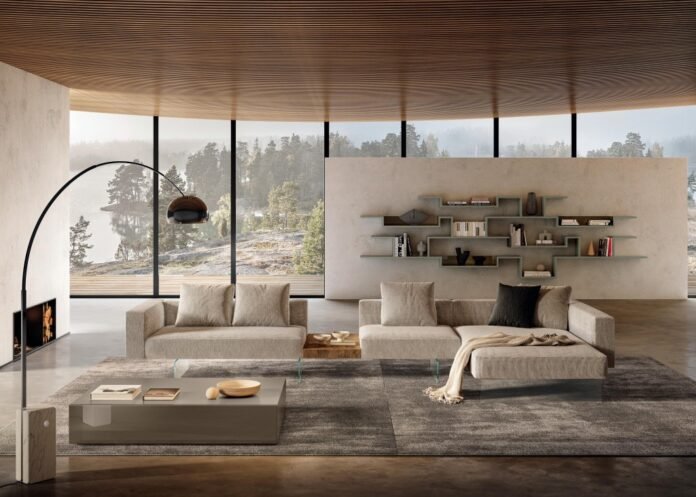Last Updated on April 28, 2024 by Umer Malik
Color is a fundamental element in interior design, capable of completely transforming the atmosphere of a room and influencing the mood of its occupants. It’s much more than just a detail: it represents an expression of personality and style, a non-verbal communication tool that can make a space welcoming, stimulating, or calming depending on the choice of hues.
The effective use of shades requires a deep understanding of their impacts both on the space and on human psychology. Interior designers often employ color to adjust or enhance the proportions of a room, direct attention to points of interest, or harmonize architectural elements. Ultimately, colors not only define the look of a room but also shape our perception and experience of the space.
Table of Contents
Theoretical foundations of color psychology
Color psychology is a field of psychology that examines the impact of colors on our behaviors and emotions. Each hue possesses characteristics that can evoke specific emotional reactions.
Blue communicates serenity and is often used to create a relaxing environment, while red can stimulate energy and is ideal for dynamic spaces like the kitchen. Understanding these impacts can help make informed choices when designing or renovating an interior.
Choosing the right palette for each space
The choice of colors should always be tailored to the function of the room. In a modern bedroom, for example, soft tones such as lavender or sky blue promote relaxation and sleep. In an office, shades like green or blue can contribute to an atmosphere of focus and calm.
It is also essential to consider the amount of natural light in the room, as it affects how colors are perceived. A good practice is to use samples to see how they change throughout the day before making a final decision.
Current trends in interior design color palettes
Color trends evolve over time, influenced by cultural and social changes. Currently, palettes tend towards neutral bases complemented by bold accents, allowing for the creation of spaces that are both modern and warm.
Neutral shades provide a subtle backdrop that allows artworks or special pieces of furniture to stand out, while color accents add character and personality to the space.
Practical tips for effectively integrating colors in interior design
To effectively integrate colors in interior design, especially through furniture, it is essential to start by defining a base palette that will serve as a backdrop. Choose neutral tones for center pieces, such as sofas or cabinets, that harmonize with most other colors.
Then, it is possible to introduce brighter color accents with smaller, interchangeable elements such as armchairs, ottomans, or side tables.
Consider the effect of each piece of furniture on the ambiance of the room. For example, a red sofa can become the focal point of a living room and stimulate the energy of the space, while a blue armchair can bring a sense of calm and serenity. Balance is always key: ensure that the distribution of colors remains harmonious and avoid visual overload.
LAGO furniture solutions: products that meet all requirements
Founded in 1976 by Giuseppe Lago, LAGO has established itself as a true reference point in the field of interior design in Italy. This company is renowned for its elegant and high-quality modern Italian furniture. They not only enhance the aesthetics of private spaces but also find their place in public places such as shops, restaurants, and hotels, where they contribute to creating unique atmospheres.
LAGO sees design as a powerful tool for social transformation. It is a discipline capable of generating meaning, not just products. This perspective allows the company to design spaces that significantly improve the quality of life. By fostering empathy and culture, LAGO creates a profound harmony between interior spaces and the individuals who inhabit them every day.
The products that are part of the collection stand out for their modular and versatile design, conceived to ensure customization and flexibility. Intended for a varied clientele, the furniture features clean and essential lines, complemented by refined and timeless design.
The production of LAGO items is based on the use of high-quality and environmentally friendly raw materials. At the heart of the company’s philosophy lies a commitment to quality and a constant quest for excellence. Each product in the collection is the result of detailed research and meticulous studies.
Today, LAGO benefits from a continuously expanding community, which includes more than 25 million users. The company actively invests in enriching its digital ecosystem, as evidenced by the online configurator, personalized furniture consultation, and the new website, launched in 2023. The latter is specially designed to enhance the user experience while reducing costs and environmental impact.
LAGO’s history has its roots in the late 19th century, a period when the first wooden furniture began to be produced. Today, under the direction of Daniele Lago, the company continues to expand its presence on the international stage, combining modern design with innovative digital approaches.
With a team of qualified managers and over 200 collaborators, LAGO continues to strengthen its global presence. The company is active in more than 20 countries and works in collaboration with a network of over 400 selected stores.
















